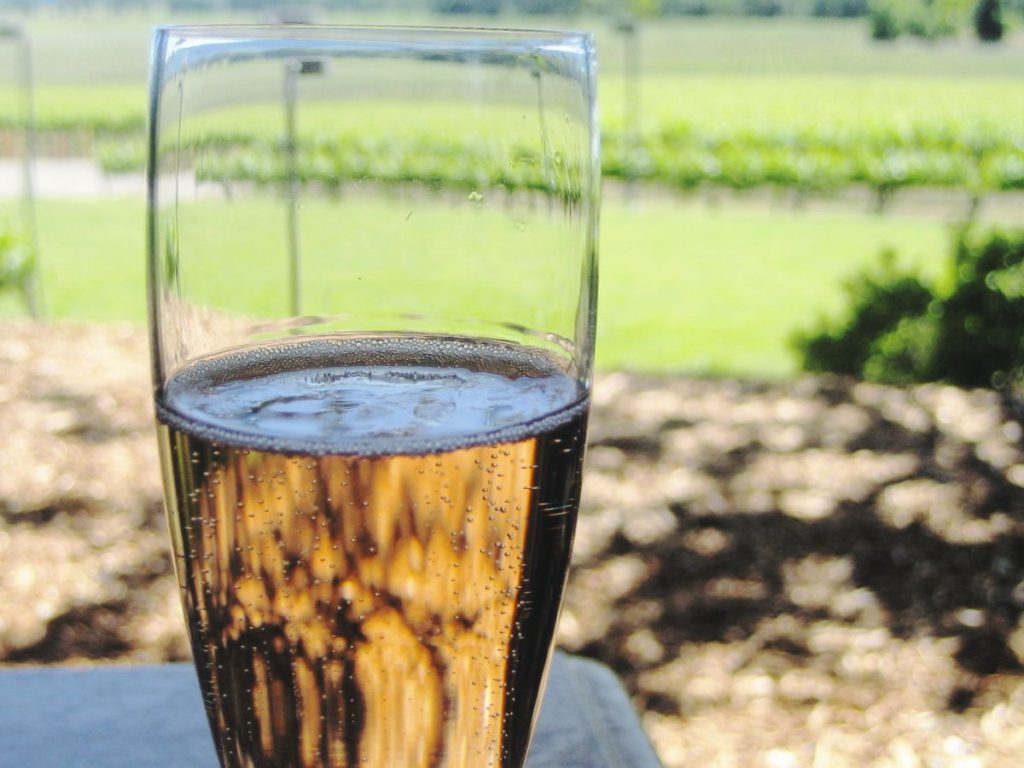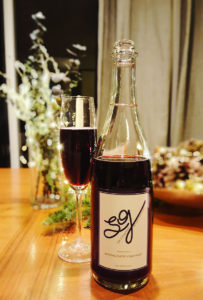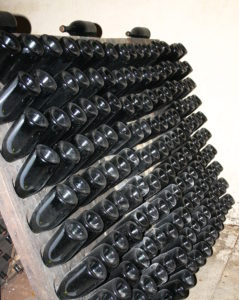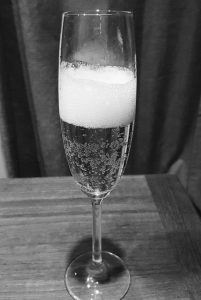
Photo by: Denise M. Gardner
The standard of identity (SOI) for sparkling wine styles are defined through 27 CFR 4, stating that sparkling wine is “grape wine made effervescent with carbon dioxide resulting solely from fermentation of the wine within a closed container, tank or bottle.”
This definition clearly outlines the parameters for using the term “sparkling” on a wine label, but there are actually a number of ways wineries can produce wines with effervescence.
Winemakers that opt to produce sparkling wine often run into the challenge of discovering standard wine production practices to optimally produce a sparkling wine. This isn’t a trick. There’s actually very little “standard” information out there regarding sparkling wine production. This means that there’s no one way to produce a sparkling wine.
However, some commonalities do exist. We’re going to break down the two different stages of sparkling wine production:
- Producing the base wine near to completion.
- Looking at the second fermentation or processing steps required to incorporate carbon dioxide into and finishing the wine.

Photo by: Denise M. Gardner
If you know that getting some extra detail on sparkling wine production is a necessity, skip ahead to the end and join our Darn Good Winemakers network. On Monday, May 20th, our session is focused on all things bubbly! (Sipping some sparkling wine during the webinar is optional.)
Producing a Base Sparkling Wine: The Varieties
This first stage of production focuses on building a base wine that can support adequate foam, but minimize the potential of gushing once carbon dioxide is retained in the wine. A foam is “a mass of small bubbles in or on the surface of a liquid” (Merriam-Webster Online Dictionary). In contrast, gushing is a violent release of bubbles within a very short amount of time. Gushing leads to financial losses (e.g., volume loss, slowing down production speed) for wineries, and customers may lose faith in a wine brand if their sparkling wine experiences gushing. Thankfully, there are several production steps winemakers can take to minimize gushing incidences.
Sparkling wine productions begins by selecting specific grape varieties the winemaker would like to use for production. Then, parameters are set for the vineyard to optimize fruit and wine chemistry associated with the sparkling wine style. Essentially, vintners look for high acid and minimal ripeness for most sparkling wines, though some exceptions may apply (e.g. Moscato). Dr. Bruce Zoecklein (2002) has previously published fruit chemistry associated with California grapes destined for the traditional method of sparkling wine production:
- Brix ranged from 17.5 – 20.0°
- pH ranged from 2.90 – 3.20
- TA ranged from 10.0 – 14.0 g/L tartaric acid
It’s important to note that traditional Champagne focuses on three grape varieties: Chardonnay, Pinot Noir, and Petit Meunier. Decades of research revolve around how these three grape varieties are grown and produced in Champagne. However, American producers have the luxury (and burden) of choosing from a number of different wine grape varieties to produce a sparkling wine. A luxury in that they can create a sparkling wine from many different varieties; a burden in that the enological data surrounding that variety likely does not exist when compared to the Champagne varieties.
Nonetheless, bubblies now range from the traditional three Vitis vinifera varieties grown locally to hybrid wine grape varieties, and even native wine grape varieties. The trick to using varieties outside of the common three is understanding how the chemistry of the base wine affects bubble formation and retention. Furthermore, understanding how the various sparkling wine processing steps influence aroma and flavor may aid a winemaker in selecting wine grape varieties to use for sparkling wines.
Producing a Base Sparkling Wine: Early Processing Steps
Juice processing influences the quality of the sparkling wine. Juice temperature, grape extraction, clarity and even the use of sulfur dioxide all impact wine quality. Ultimately, this may later late stream processing decisions post-primary for the winemaker. It’s recommended that great consideration is used during pre-fermentation processing decisions for these reasons.
The goal of primary fermentation, for most styles of sparkling wine, is to ferment to dryness while eliminating the potential of wine faults or flaws. As the presence of wine flaws will be exacerbated by the carbon dioxide (when the wine is bottled), winemakers take great care in managing wine quality through all stages of sparkling wine production. For this reason, considerations for things like nutrient supplementation during primary fermentation is taken seriously. While winemakers should take advantage of good manufacturing practices, like measuring YAN (yeast assimilable nitrogen), for all wines produced, these practices are essential to make quality sparkling wines.
Finally, before a base wine can move onto the second group of production stages to incorporate carbon dioxide, the base wine often needs to be stabilized. This includes both cold and heat (protein) stabilization. The base wine should get tested for both cold and protein stability prior to treatment.
Finishing a Sparkling Wine: Incorporating Carbon Dioxide

Photo by: Denise M. Gardner
Either a second fermentation or a series of specific processing steps follows once the base wine has been stabilized. These steps incorporate carbon dioxide into the wine, hence finishing it. There are a number of ways a winemaker may choose to add carbon dioxide to a wine. Each method has its own advantages or disadvantages and some may require specialized equipment:
- Traditional Method (a.k.a. Méthode Champenoise, Méthode Traditionelle): In this method, the base wine is first fermented in bulk. Base wines may then get blended (often referred to as a cuvée), stabilized, and bottled with a sugar and yeast addition (tirage, liqueur de tirage). The addition of the tirage indicates that a second fermentation will progress inside the bottling, creating and retaining carbon dioxide. When the second fermentation is completed, the precipitated yeast are riddled down to the neck of the bottle and eventually disgorged. The bottle is then immediately filled with a final sugar solution (dosage, liqueur d’expédition) and sealed with a Champagne cork. The sugar level of the dosage determines the final sweetness for the sparkling wine.
- Charmat Method (a.k.a. Tank Method): As discussed previously, the base wine is first fermented in bulk and may be blended into a cuvée. The cuvee is then transferred into a cold, pressurized tank instead of a bottle. Yeast and sugar are first added to the receiving tank, and this addition will initiate the second alcoholic fermentation under pressure, which retains developed carbon dioxide. The carbonated wine is then filtered and transferred to a second pressurized tank, which contains the final dosage. The wine is then bottled under pressure.
- Transfer Method: This is a hybrid method of both Traditional and Charmat processes. The Transfer method follows the same production steps as the traditional method up through the second fermentation in the bottle. However, after riddling, the bottles are then emptied into a pressurized tank, filtered, and moved to a second pressurized tank that contains the final dosage similar to the Charmat method. Wines are then bottled into a new bottle under pressure. These wines are usually labeled with the phrase “Fermented in the Bottle” or “Bottle Fermented.”
- Forced Carbonation: The base wine is produced like any still table wine. The wine will likely undergo normal stabilization processes or product additions, but with consideration towards how those processes/additions could affect foam and bubble retention. At bottling, the wine undergoes a direct addition of carbon dioxide and bottled under pressure.
Learn More about Sparkling Wine Production
On Monday, May 20th, the Darn Good Winemakers are meeting with a featured webinar titled, It’s All About that Base: Sparkling Wine Production Details. While we’ll review all of the topics above in greater detail, members will walk away with:

- A greater understanding of ideal grape chemistry parameters to produce sparkling wines with ease.
- Best production practices for creating a base wine or cuvée that delivers optimal quality for sparkling wines.
- When and how to properly stabilize sparkling wines.
- A brief review of the five ways carbon dioxide is incorporated into a base wine.
Remember, your Darn Good Winemakers membership lasts for 12 consecutive months. It provides you with access to all previously-held sessions. And, it gives you time to chat with me, once-per-month, without ever paying a consulting fee.
References
Merriam-Webster Online Dictionary
Zoecklein, B. (2002). A Review of Méthode Champenoise Production.
